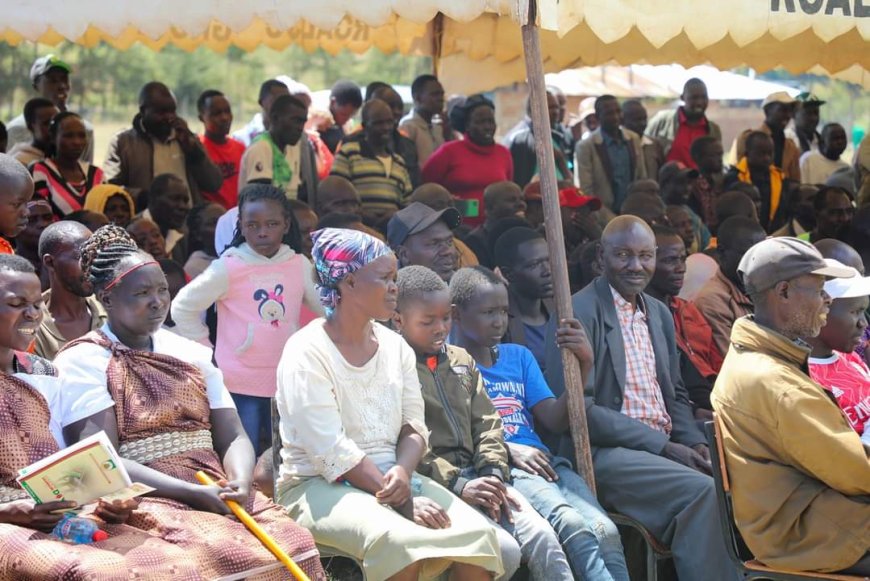More women seeking information on NCDs in Nyeri

Nyeri,
Wednesday November 13, 2023
KNA by Samuel Maina
At least 32 per cent of women in Nyeri county aged between 15 and 49 years have been examined by a health worker for breast and cervical cancer in contrast to a 17-percentage national tally.
According to the 2022 Kenya Demographic and Health Survey (KDHS) from the Kenya National Bureau of Statistics (KNBS) more women in the county were also screened for cervical cancer compared to breast cancer with the latter accounting for only 25 percent of those tested.
The survey interviewed 529 women in the county with a response rate of 97 per cent and 289 men whose response rate stood at 95 per cent.
The survey also found that more women had been diagnosed with hypertension compared to their male counterparts.
For instance, while 14 percent of women in Nyeri had been informed by a doctor or health care worker that they had high blood pressure, only five per cent of men were aware of their status.
Depression was also found to be slightly higher among women at six per cent, with only three per cent of men having the health challenge.
According to a survey, the country is currently grappling with an epidemiological transition in its disease burden from traditionally known communicable diseases to no communicable diseases such as cancer, diabetes and hypertension.
This challenge is currently to blame for 39 per cent of all deaths in the country according to the 2018 World Health Organization (WHO) report.
“Kenya is experiencing an epidemiological transition in its disease burden from predominantly communicable diseases to a rapidly rising burden of non-communicable diseases. This has resulted in a “triple burden of disease,” which is increasingly straining the health system. It is estimated that 39% of deaths in the country are as a result of NCDs (WHO 2018), with the four major NCDs: cardiovascular diseases (CVDs), cancers, diabetes, and chronic respiratory diseases accounting for 57 % of all NCD Deaths,” reads part of the key findings of the survey.
The survey also found that more women in the county had visited a health facility to know their HIV status compared to men.
For instance, during the time of the survey (February 17 to July 31 2022), while 56 percent of women who underwent the interview disclosed having tested for HIV in the last 12 months, only 40 per cent of the men had undertaken the test.
The same was replicated at the national level where only 39 per cent of men had tested for HIV compared to women at 47 per cent.
Overall 90 percent of women across the 47 counties said they had at one time been tested for HIV and received their results compared to men at 78 per cent.
Currently there are 1.4 million living with HIV in Kenya with 200,000 of them out of Antiretroviral treatment.
During last year’s fete to mark the World Aids Day Nyeri County Director of Health Services Dr. Nelson Mureu said the government had embarked on a five-year plan to address the HIV/Aids disease burden including setting up 41 health facilities to attend to those living with the disease.
He also disclosed the county government was putting up intervention to ensure prevalence rates in the area remain below the national tally with special focus targeting the youth who account for 90 per cent of all new infections in Nyeri.
“We have impact interventions that are being employed by all the stakeholders. We have in excess of 20,000 population that are actually living with the disease and 98 per cent are on treatment. Currently we have started what we call a journey to self-reliance where our health facilities are being funded directly using funds from the county government in the face of dwindling donor assistance,” he said.
“As we look into new infections, remember that we also appreciate the data we have. Moving forward we need to have a conservation targeting the youth including at policy level since whatever we do, if we neglect one side, we are not going to achieve especially with the increased cases of teenage pregnancies,” he added.
In matters of attitude towards Gender Based Violence (GBV) more men appear to support the practice terming it a “necessary corrector of wrongs’’ compared to women.
While only 27 per cent of men gave at least one specified reason in favour of wife beating the figure rose to 49 per cent among men.
Among reasons advanced for beating female partners ranged from refusal to give in to sexual demands, arguments, leaving the house without informing their partners to petty matters like overcooked food.
Overall, 15 percent of women from Nyeri who were interviewed from a sample size of 833 households said they had undergone some form of GBV by a male partner within the time of the study.
Surprisingly out of those who had undergone this violence, only 38 per cent sought help to stop the violence while 43 per cent decided to keep silent.
In addition, 40 per cent of the interviewees said those who had met violence on them were their husbands or intimate partners.
The forms of violence ranged from emotional, physical to sexual.
The good news however is that at the national level, the number of women who have experienced physical violence declined between 2008 and 2022 from 24 percent to 16 percent, a slight drop of eight percent.
“The percentage of women who experienced physical violence in the 12 months before the survey declined between 2008-09 and 2022, from 24 percent to 16 percent. The percent of men who have experienced physical violence in the 12 months before the survey declined slightly from12 percent in 2014 to 10 percent in2022 per cent,” the survey says.
Courtesy; KNA
What's Your Reaction?
































































































































































































































































































